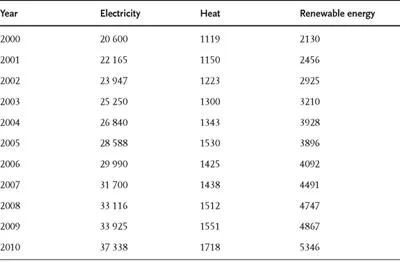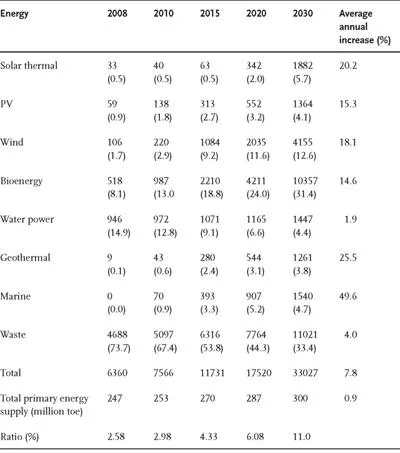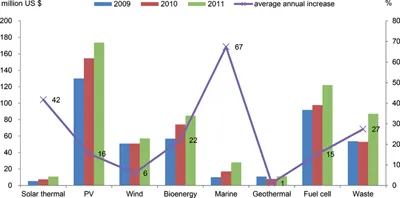
- English
- ePUB (mobile friendly)
- Available on iOS & Android
eBook - ePub
Transition to Renewable Energy Systems
About this book
In this ready reference, top academic researchers, industry players and government officers join forces to develop commercial concepts for the transition from current nuclear or fossil fuel-based energy to renewable energy systems within a limited time span. They take into account the latest science and technology, including an analysis of the feasibility and impact on the environment, economy and society. In so doing, they discuss such complex topics as electrical and gas grids, fossil power plants and energy storage technologies. The contributions also include robust, conceivable and breakthrough technologies that will be viable and implementable by 2020.
Frequently asked questions
Yes, you can cancel anytime from the Subscription tab in your account settings on the Perlego website. Your subscription will stay active until the end of your current billing period. Learn how to cancel your subscription.
At the moment all of our mobile-responsive ePub books are available to download via the app. Most of our PDFs are also available to download and we're working on making the final remaining ones downloadable now. Learn more here.
Perlego offers two plans: Essential and Complete
- Essential is ideal for learners and professionals who enjoy exploring a wide range of subjects. Access the Essential Library with 800,000+ trusted titles and best-sellers across business, personal growth, and the humanities. Includes unlimited reading time and Standard Read Aloud voice.
- Complete: Perfect for advanced learners and researchers needing full, unrestricted access. Unlock 1.4M+ books across hundreds of subjects, including academic and specialized titles. The Complete Plan also includes advanced features like Premium Read Aloud and Research Assistant.
We are an online textbook subscription service, where you can get access to an entire online library for less than the price of a single book per month. With over 1 million books across 1000+ topics, we’ve got you covered! Learn more here.
Look out for the read-aloud symbol on your next book to see if you can listen to it. The read-aloud tool reads text aloud for you, highlighting the text as it is being read. You can pause it, speed it up and slow it down. Learn more here.
Yes! You can use the Perlego app on both iOS or Android devices to read anytime, anywhere — even offline. Perfect for commutes or when you’re on the go.
Please note we cannot support devices running on iOS 13 and Android 7 or earlier. Learn more about using the app.
Please note we cannot support devices running on iOS 13 and Android 7 or earlier. Learn more about using the app.
Yes, you can access Transition to Renewable Energy Systems by Detlef Stolten,Viktor Scherer in PDF and/or ePUB format, as well as other popular books in Physical Sciences & Energy. We have over one million books available in our catalogue for you to explore.
Information
Part I
Renewable Strategies
1
South Korea’s Green Energy Strategies
1.1 Introduction
The purpose of this chapter is to present an overview of South Korea’s green energy strategies and policy goals set under the National Strategy for Green Growth: (1) government-driven strategies and policy towards green growth; (2) to narrow down the focus and concentrate on R&D for a new growth engine; and (3) to promote renewable energy industries.
The Republic of Korea is the world’s fifth largest importer of oil and the third largest importer of coal [1] (see Table 1.1). Our green growth plan is to increase the share of new and renewable energy in the total energy supply from 2.7% in 2009 to 3.78% in 2013; we aim to double that share to 6.08% by 2020 and 11% by 2030 (Figure 1.1). The statistics of energy consumption from 2000 to 2010 in South Korea are presented in Table 1.2. The energy policy has focused on dealing with oil prices and supply during the post-oil shock period in the mid-1970s [2], but today’s energy policy includes the plan and actions for addressing climate change and environment protection and securing energy resources. The Korean government has strategically emphasized the development of 27 key national green technologies in areas such as solar and bio-energy technologies, and pursued the target through various policy measures, such as the Renewable Portfolio Standard (RPS), waste energy, and the One Million Green Homes Project.
Figure 1.1 A scenario of renewable energy utilization plan from 2008 to 2030; toe, tonnes of oil equivalent.
Source: MKE [3].

Table 1.1 Producers, net exporters, and net importers of crude oil, natural gas, and coal.
Source: IEA [1].

Table 1.2 Statistics of energy consumption (thousand toe) from 2000 to 2010 in South Korea.
Source: MKE [13].

Thus, Korea’s plan is to reduce carbon emissions, improve energy security, create new economic growth engines, and improve the quality of life based on green technologies.
In August 2008, Korean President Lee announced a “low-carbon, green growth” strategy as a new vision to guide the nation’s long-term development. Five months later (January 2009), the Korean government responded to the deepening recession with an economic stimulus package, equivalent to US$ 38.1 billion, of which 80% was allocated towards the more efficient use of resources such as freshwater, waste, energy-efficient buildings, renewable energies, low-carbon vehicles, and the railroad network. In July 2009, a Five-Year Plan for Green Growth was announced to serve as a mid-term plan for implementing the National Strategy for Green Growth between 2009 and 2013, with a fund totaling US$ 83.6 billion, representing 2% of Korea’s GDP. It was expected to create 160 000 jobs in the green sector, providing opportunities for both skilled and unskilled labor; the forecast rate was ∼35 000 additional jobs per year between 2009 and 2013 [4].
The national goals had been established through strategies and policies such as the Presidential Committee on Green Growth [4], the National Basic Energy Plan and Green Energy Industry Development Strategy [5], the Basic Act on Low Carbon Green Growth and Related Legislation [6], and National Strategy and Five-Year Implementation Plan [4]. Eventually, the goal for Korea is to move away from the traditional “brown economy” to a “green economy” model where long-term prosperity and sustainability are the key objectives.
1.2 Government-Driven Strategies and Policies
In an effort to push forward the national goals, the Presidential Committee on Green Growth (PCGG) [4] was launched to facilitate collaboration in deliberating and coordinating various green growth policies across ministries and agencies. Green growth committees were also set up under local governments. Both the central government and local governments worked out 5 year green growth plans and have invested 2% of the GDP annually. Also, the Korean government was the first in the world to lay the groundwork for the continued pursuit of green growth by enacting the Framework Act on Low Carbon, Green Growth. It paved the way for reducing greenhouse gas (GHG) emissions in a groundbreaking manner through a market system by legislating the Greenhouse Gas Emissions Trading Act, supported across various political parties. Thus the government prepared the legal and institutional groundwork and also the framework for putting green growth as the new paradigm for national progress into practice.
The National Basic Energy Plan [7] established specific measures to increase energy efficiency, decrease energy intensity, and achieve the target to increase the renewable energy portfolio to 11% by 2030. The government plans on reaching this target by implementing programs such as the Smart Grid, the Two Million Homes strategy (which aims to have two million homes run on a mix of renewable energy resources by the end of 2018) and an 11 year renewable energy portfolio standard (RPS), which will replace the Renewable Portfolio Agreement (RPA) and feed-in tariffs (FITs) currently in operation by 2012. In 2005, the Ministry of Knowledge Economy (MKE)’s predecessor, the Ministry of Commerce, Industry and Energy, established the RPA, signing an agreement with the nine largest energy suppliers to provide financial support of US$ 1.1 billion between 2006 and 2008 and administrative support for clean and renewable energy projects. The aim was to increase the use of clean and renewable energy in the industrial sector and reduce 170 000 tons of GHG FIT regulations mandate electricity utilities to buy electricity generated by clean and renewable energy at a price fixed by the government, which then compensates the utility to offset the difference in price from conventional energy supplies. It has been noted that the FIT market-based instrument has been the driver behind the increased supply of clean and renewable energy in the nation but has also been criticized as being anti-competitive and causing difficulty in forecasting electricity generation. Because of this, the government planned to replace the FIT in 2012 with the RPS that will mandate utilities to generate a specific amount of clean and renewable energy. The RPS will be operated by the MKE and will mandate utilities with generation capacity over 2000 MW to obtain certain amount of renewable energy. The amount of renewable generation mandated was 2% in 2012, increasing to 10% in 2022. Participants will be able to meet their quotas either by buying renewable energy certificates (RECs) from independent power providers, or by earning RECs through their own generation. The expected share of the individual green energy sources for the 11% for 2030 is illustrated in terms of photovoltaics (PV), wind, bioenergy, and so on in Table 1.3.
There were two approaches leading this green energy technology effort: (1) select 27 key green technologies to concentrate on while bridging the technology gap, and (2) establish an assistance program for green technology R&D to lead emerging green technology for the future. The Green Energy Industry Development Strategy focused on both early growth engine technologies, such as PV, wind, smart grids and LEDs, and next-generation growth engines, including carbon capture and storage, fuel cells, and integrated gasification and combined cycle technologies.
PCGG developed the legislative framework for green growth, called the Basic Act on Low Carbon Green Growth. In January 2010, the Korean President signed and promulgated this Act, which mandated a target for GHG emission reductions, renewable energy supply, and energy savings and security.
Table 1.3 Prediction of renewable energy demand (thousand toe) and (in parentheses) the expected share of the individual green energy sources (%).
Source: MKE [3].

1.3 Focused R&D Strategies
For the growth of renewable energy, strategic R&D is required. The Korean government has identified renewable energy as its next engine for growth by focusing on selected R&D investments and increasing its budget (Figure 1.2 and Table 1.4). In 2011, the MKE announced the strategy of renewable energy R&D [8] by selecting five core sectors for power generation technologies: PV, wind power, bioenergy, coal, and fuel cells.
Figure 1.2 R&D budget of renewable energy in South Korea.

Table 1.4 R&D budget of renewable energy in South Korea.
Source: GTC-K [9].

The commercial and technical feasibility of renewable energy requires a considerable level of R&D and field demonstration. It also requires a fully integrated approach across many interdepartmental agencies. For example, offshore wind projects [10] have been planned for both South Korea’s southwest coast and the southern island of Jeju. Its target has been to generate 100 MW offshore wind capacity by 2013, and to achieve 600 MW by 2016 and 2.5 GW by 2019. This included not only an increased R&D budget, but also an intensive field demonstration project plan for global applications.
1.4 Promotion of Renewable E...
Table of contents
- Cover
- Contents
- Title Page
- Author
- Copyright
- Foreword
- Preface
- List of Contributors
- Part I: Renewable Strategies
- Part II: Power Production
- Part III: Gas Production
- Part IV: Biomass
- Part V: Storage
- Part VI: Distribution
- Part VII: Applications
- Subject Index